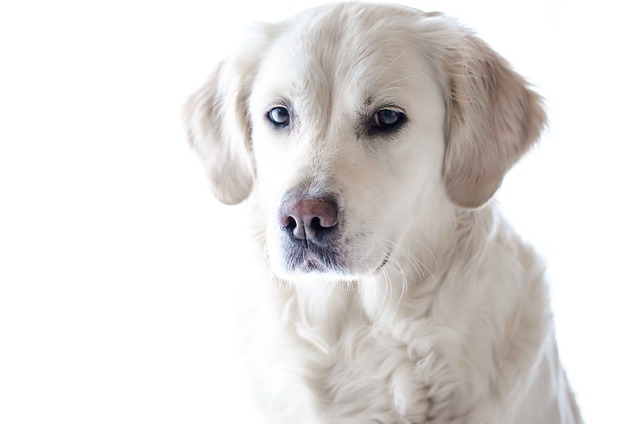
What is glaucoma in a dog?
You might notice your dog squinting more at mealtime or avoiding bright sunlight—these small changes could be early signs of a serious eye condition.
Golden retrievers, with their sunny, gleaming golden coats, always exude a charming allure. Their warm and friendly personalities bring endless joy to countless families. However, when fungal infections silently strike these lovely furry friends, their once smooth and shiny coats become messy, and the dogs become restless due to itching, which breaks every owner's heart. When facing fungal infections in golden retrievers, how can we carry out scientific and effective treatment?
First of all, accurately identifying the symptoms of fungal infections in golden retrievers is the crucial first step. Fungal infections most commonly occur on the dog's skin, ears, paws and other parts. When the skin is infected, circular or oval hair loss areas will appear. The skin in the hairless areas is red, may be accompanied by dandruff, and scabs may form in severe cases. Golden retrievers may frequently scratch and lick the infected area in an attempt to relieve the itching. For example, if you suddenly notice several bald patches on your golden retriever and the skin looks red and rough, it is likely a sign of a fungal infection. After the ears are infected with fungi, there will be an increase in earwax and a bad smell. The dog will shake its head and scratch its ears from time to time, showing signs of ear discomfort. If the paws are affected by a fungal infection, the toes may become swollen, red and hairless. The dog will limp when walking and obviously feel pain.
Once a fungal infection in a golden retriever is suspected, it is essential to take it to a pet hospital as soon as possible. Veterinarians will make a diagnosis through professional examinations, such as the Wood's lamp examination, in which certain fungi will emit fluorescence of a specific color under the irradiation of the Wood's lamp. There is also the skin scraping examination to observe under the microscope for the presence of fungal spores and hyphae. After the diagnosis is confirmed, the treatment officially begins.
 Drug treatment is the core of treating fungal infections in golden retrievers. Topical antifungal drugs are one of the commonly used methods, such as ointments or sprays containing ketoconazole, itraconazole and other ingredients. When using them, the hair in the infected area should be carefully shaved off first. This allows the drug to come into better contact with the skin and makes it easier to observe the treatment effect. Then, apply the ointment or spray evenly on the infected area according to the veterinarian's instructions, usually 1 to 2 times a day. When applying, be gentle, as if taking care of a precious treasure, to avoid hurting the dog. At the same time, prevent the dog from licking the medicine to avoid affecting the efficacy or causing other discomforts. You can put an Elizabethan collar on the dog.
Drug treatment is the core of treating fungal infections in golden retrievers. Topical antifungal drugs are one of the commonly used methods, such as ointments or sprays containing ketoconazole, itraconazole and other ingredients. When using them, the hair in the infected area should be carefully shaved off first. This allows the drug to come into better contact with the skin and makes it easier to observe the treatment effect. Then, apply the ointment or spray evenly on the infected area according to the veterinarian's instructions, usually 1 to 2 times a day. When applying, be gentle, as if taking care of a precious treasure, to avoid hurting the dog. At the same time, prevent the dog from licking the medicine to avoid affecting the efficacy or causing other discomforts. You can put an Elizabethan collar on the dog.
For more severe fungal infections, oral antifungal drugs are also required. These drugs can inhibit the growth and reproduction of fungi in the dog's body. However, oral medications may have some side effects, such as affecting liver function. Therefore, during the medication period, the dosage and course of treatment must be strictly in accordance with the veterinarian's instructions, and the dog should be taken to the hospital for reexamination regularly to monitor various physical indicators. For example, veterinarians may accurately calculate the daily dosage according to the golden retriever's weight and the degree of infection. Owners must administer the medicine on time and in the right amount, and must not randomly increase or decrease the dosage.
In addition to drug treatment, daily care also plays a vital role in the recovery of golden retrievers. Keeping the dog's living environment clean and dry is of utmost importance. Fungi like to grow in damp and dark environments, so it is necessary to frequently clean and replace the dog's cushions and toys and regularly disinfect the dog house. You can use pet - specific disinfectant, dilute it according to the instructions, and wipe every corner of the dog house. At the same time, let the golden retriever get more sunlight. The ultraviolet rays in the sun have a bactericidal effect and can help inhibit the growth of fungi. Take the dog to an outdoor sunny place for a while every day. This is not only beneficial to the skin health but also makes the dog happy.
In terms of diet, it is necessary to ensure that the golden retriever takes in sufficient nutrition to enhance its resistance. High - quality dog food is rich in nutrients such as protein, vitamins and minerals, which can provide the energy needed by the dog's body. In addition, you can appropriately supplement the dog with some foods rich in Omega - 3 fatty acids, such as fish oil, which helps improve skin health and reduce inflammation.
Watching the once lively golden retriever become listless due to fungal infections, owners are full of worry. But as long as we actively cooperate with the veterinarian's treatment, carefully do a good job in daily care, and accompany the dog through this difficult time with full love, we will surely be able to help them overcome the fungal infection, regain their former vitality, once again have that enviable beautiful coat, and run and play cheerfully by our side. Let's cheer for the health of golden retrievers and protect this precious companionship.

You might notice your dog squinting more at mealtime or avoiding bright sunlight—these small changes could be early signs of a serious eye condition.

Let’s set the scene: It’s a sweltering Phoenix afternoon—105°F outside—and you rushed your 2-year-old Lab mix, Cooper, on a quick walk to “get it over with.”

Let’s get real: You’re in your Miami apartment, watching your 3-year-old Corgi, Loki, struggle to climb the stairs to your second-floor unit.

Many dog owners brush off occasional scratching as just “dog behavior,” but persistent itching often signals something more—like a food allergy.

You might first notice your dog scratching more than usual—chewing at their paws until the fur looks thin, or rubbing their face against the couch nonstop.

Let’s be real: You’re standing in your Chicago apartment, watching your 3-year-old Beagle, Max, huff and puff just to climb onto the couch.